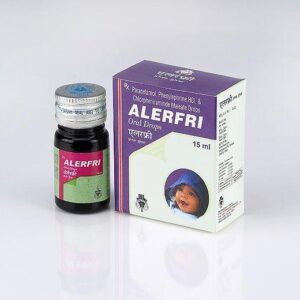CHLORPHENIRAMINE + PARACETAMOL (ACETAMENOPHEN) + PHENYLEPHRINE + NOT AVAILABLE
Chlorpheniramine: Chlorpheniramine is an antihistamine commonly used to relieve symptoms of allergies, such as sneezing, runny nose, itching, and watery eyes. It is available both over-the-counter and by prescription in various forms, including tablets, capsules, liquids, and nasal sprays.
The drug works by blocking the effects of histamine, a substance produced by the body in response to an allergen. Histamine is responsible for causing the characteristic symptoms of allergies. By inhibiting histamine activity, chlorpheniramine helps alleviate these symptoms.
The recommended dose of chlorpheniramine may vary depending on the form and strength of the medication. Typically, for adults and children 12 years and older, the usual oral dose is 4 mg every 4 to 6 hours. For children 6 to 11 years old, the recommended dosage is 2 mg every 4 to 6 hours. The dose for children under 6 years old should be determined by a healthcare provider.
As with any medication, chlorpheniramine can cause side effects. Common side effects may include drowsiness, dizziness, blurred vision, dry mouth, constipation, and urinary retention. These side effects are more likely to occur at higher doses or with prolonged use. Some individuals may also experience agitation or excitability as a paradoxical reaction.
Chlorpheniramine should be used with caution in individuals with certain conditions, such as asthma, glaucoma, urinary retention, peptic ulcer, or prostate enlargement. It may also interact with other medications, including central nervous system depressants like alcohol or sedatives.
It is important to follow the recommended dosage and avoid exceeding the recommended duration of use to minimize the risk of side effects. If symptoms persist or worsen, it is advisable to consult a healthcare professional for further evaluation and alternative treatment options.
Paracetamol (acetamenophen): Paracetamol, also known as acetaminophen, is a widely used over-the-counter medication commonly used for pain relief and reducing fever. It is a non-opioid analgesic and antipyretic drug.
Paracetamol works by inhibiting the synthesis of prostaglandins, which are chemical messengers involved in the transmission of pain and fever signals in the body. By blocking the production of these chemicals, it helps to reduce pain and fever.
This drug is primarily used for the treatment of mild to moderate pain, such as headaches, toothaches, menstrual cramps, and muscle aches. It is also utilized to reduce fever associated with common colds, flu, and other viral or bacterial infections.
The dose of paracetamol varies depending on age, weight, and the severity of the condition being treated. For adults, the usual recommended dose is 500-1000 mg every 4-6 hours, not exceeding 4000 mg in a 24-hour period. For children, the dose is determined based on their weight, usually around 10-15 mg/kg every 4-6 hours.
While paracetamol is generally considered safe when used appropriately, it can cause side effects in some individuals. Common side effects include nausea, upset stomach, and liver toxicity at high doses. It is important to follow the recommended dosage guidelines and avoid exceeding the maximum daily dose to minimize the risk of liver damage. Allergic reactions to paracetamol are rare but can occur, and symptoms may include skin rashes, itching, and difficulty breathing.
It is essential to consult a healthcare professional or read the package insert for specific instructions and recommendations for the use of paracetamol, as certain individuals may have contraindications or require adjusted dosages due to underlying medical conditions or medications they may be taking.
Phenylephrine: Phenylephrine is a medication commonly used as a decongestant and to temporarily relieve nasal congestion due to various conditions such as the common cold, allergies, and sinus infections.
Its main mechanism of action is as a selective alpha-1 adrenergic receptor agonist. By binding to these receptors in the nasal blood vessels, it causes vasoconstriction, reducing blood flow and swelling in the nasal passages.
Phenylephrine is available in various forms such as nasal sprays, nasal drops, tablets, and liquids. The dose and strength may vary depending on the specific product and the age of the patient.
For nasal congestion, the typical recommended dose for adults and children over 12 years old is 2 to 3 sprays in each nostril every 4 hours, not exceeding 3 doses in 24 hours.
As with any medication, Phenylephrine may cause some side effects. Common side effects include a mild burning or stinging sensation in the nose, sneezing, temporary nasal dryness, headache, and increased blood pressure. These side effects are usually mild and short-lived.
In some individuals, especially those with underlying medical conditions like heart disease or high blood pressure, Phenylephrine may cause more severe side effects such as chest pain, fast or irregular heartbeat, difficulty breathing, or severe dizziness. If any of these occur, it is important to seek immediate medical attention.
Phenylephrine should not be used in children under the age of 4 without the advice of a healthcare professional. It is also important to follow the recommended dosage and avoid exceeding the maximum dose or frequency of administration specified by the healthcare provider or indicated on the product packaging.
Not Available: I’m sorry, but you have not provided the name of a specific drug for me to describe. Could you please provide the name of a specific drug?

